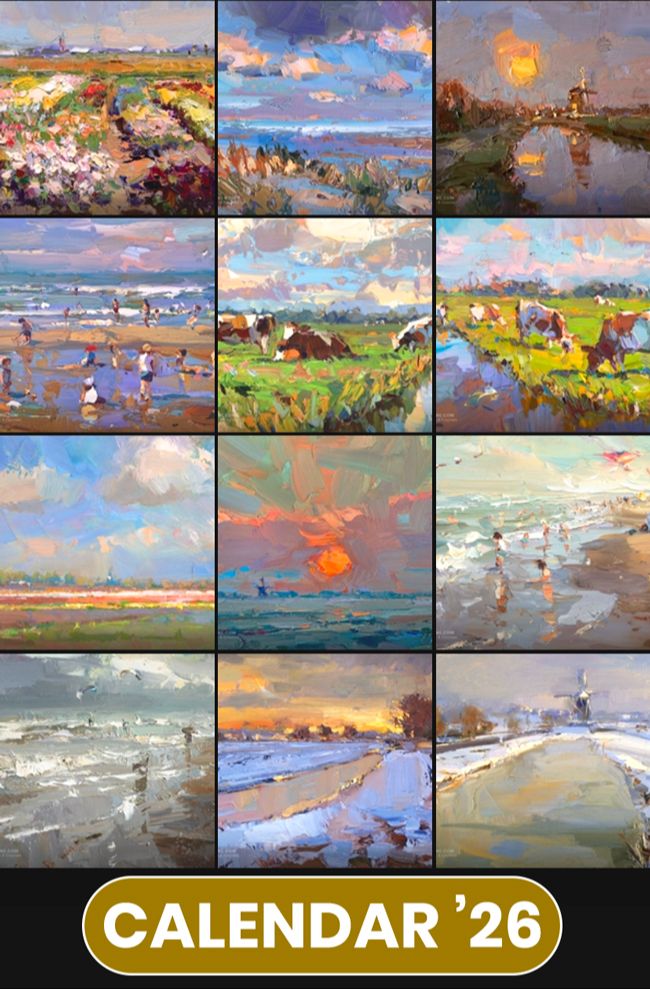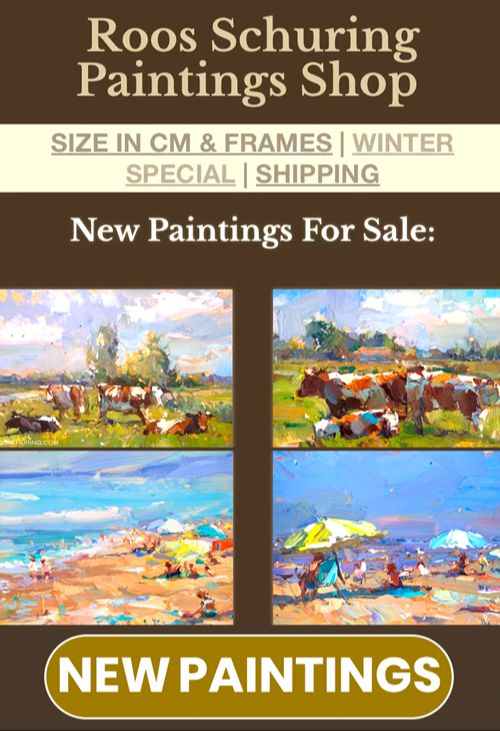Blog / StoriesFrom The Field
Paintings in Oils by Roos Schuring.
Plein air painting, Images & Videos, Enjoy!
Painting Cows Under Big Sky

Painting Cows & Sky.
Below I talk about Color Correcting pictures. "My!": It took 3000 characters to explain :) And you'll probably still email me your questions. There are 1000 ways to Rome is all I can say, but there I tell you about my ways in this.
About this Painting -
Sometimes you just want to paint the vast sky. My favorite sky moment: the grey hanging over the scene, and having the 'open' lit sky below it. Here the clouds are lit creamy around them. And the landscape is mostly in shade. Pretty Dutch scene.

LSP15-2016 Landscape Pleinair Painting 'Cows Under Big Sky'
oil on canvas, 24x30 cm | 9.6" x 11.8" 2016 (sold) Find Landscapes for Sale here:
Photographing Paintings:
Here below a phone snapshot of the scene and palette used. These pics also show why color correction after the fact is o-so important.
Color Correcting
I photograph in 'RAW', after uploading I adjust contrasts, color warmth, then I open it in Photoshop, get the light back in, etc. Color correcting takes me about 40 minutes per image. I then also have the real painting in hand to compare.
➜Tip: Often you see your imagery look different on an Ipad or Tablet compared to your desktop computer, phone or other. How can you make sure you are color correcting it 'right'? I found that there's 1 most objective measurement in this. Here it is:
When you create PR material with photo imagery on: the way these things come out is often a good indicator if your monitor is set 'right'. Right would mean: 'What you see is what you get'.
Which 'Monitor' is 'right'?
Example: When I've color corrected an image 'right': A) the desktop monitor shows me the same colors as the real painting + B) the print from my laser printer is almost the same + C) the PR paper material I get from diverse printing companies = the same THEN my monitor shows images correctly. (Yes, you have programs to set monitors 'right', but I haven't found these to be my solution.)
After you'll have to let go of 'How your images are shown' on other people's computers, phones, pads. You can't control other people's monitor settings. Or the difference between a phone and desktop monitors.
Doing it this way - (! and you can use diverse printing companies, for example, to know it's not their settings but really the image document that decides how the paper image turns out) - you'll be perhaps 'closest' to the real deal: the real painting.
Experiment
Don't get me wrong: color correcting still is one of the hardest things and often you just WON'T get it 'perfect'. And you can also use a company of some sort to do the photographing for you. You can photograph using lights, you can photograph in the full sun, or indoors in shade with a tripod. You can use a light tent. I've tried all. The best thing for me now is to photograph indoors, using no light except natural light on a mild overcast day. I'm using the tripod and a good camera. I make sure the ISO is set to 250-400. For me colors are most important. I like the manual settings. Not the automatic. I threw out the light tent, I don't want the extra light on. I found when you photograph with too much light it will destroy the lower contrasts. The more you develop your 'seeing' the more these little things you notice, and you'll find yourself adjusting photos far different compared to years before. Then 'brightness' and 'contrast' won't do anymore, and you'll be fussing for hours getting it right.
Experiment with 1 painting: photograph indoors, outdoors, with a tripod, without, on automatic settings, on manual, change things around: and see what works. Make notes doing so and first of all, get a good digital (mirror reflex) camera. A phone camera just won't do I think because of wrong colors, wrong contrasts and the small lens. Success!
PS. Update 2020: Phone cameras have become a lot better, still these enhance contrasts, sometimes to your benefit, but often not. I still photograph everything on a tripod and with a good camera to make photos resemble the actual painting better. My current camera is a Canon M50.

(2016: here were the phone cameras really not as good as in for example 2020.)

Find an overview of my ► Tools, gear and equipment for outdoor painting here.
► Study Painting Cows in Landscapes: find all info here.
Posts and Paintings per Category:
■ SEASCAPES
■ SUNRISE-SUNSET
■ CLOUDS
■ GREY
■ LANDSCAPES
■ NOCTURNES
■ COWS
■ SNOW
■ SUMMER
■ FIGURES
■ FLOWERS
GET MY LATEST VIDEOS INTO YOUR INBOX
Stay In The Loop
If you want to get notified when I have published New Vlogs, you can get my Blog-Vlog update every month. Sign up here
✔ Blog Digest Monthly
✔ Watch New Vlogs
✔ View New Paintings First
✔ View New Products First
(✔ Best deals)








